Digital Twin-Based Zero-Touch Management for IoT
Abstract
1. Introduction
- (1)
- Centralized control: DT has a global view of the network, which is conducive to centralized control of heterogeneous networks;
- (2)
- Device abstraction: DT hides the heterogeneity between devices, so there is no need to consider the underlying implementation details of devices
- (3)
- Flexible control: DT can dynamically change the network configuration according to the actual network status and the administrator’s intentions.
- (1)
- Ontology and knowledge mapping technology is employed to model IoT devices and IoT networks, thus supporting the DT of IoT and realizing real-time digital expression of the network through continuous collection of equipment and network environment information
- (2)
- Based on the DT of the IoT, a zero-touch management architecture of the IoT is designed, which helps to solve the problems of equipment management and network optimization in the IoT and to formulate corresponding automated solutions, to minimize manual participation in the management process.
2. Related Work
3. Twin Modeling of the IoT
3.1. Architecture of IoT
3.2. Device Twin Model
3.3. Network Twin Model
4. Twin-Based Zero-Touch Management
4.1. Zero-Touch Management Architecture
4.2. Device Management
4.2.1. Device Access
4.2.2. Remote Monitoring
4.2.3. Software Upgrade
4.2.4. Feedback Control
4.3. Network Optimization
5. A Smart Home Instance
5.1. Twin Modeling for a Smart Home
5.2. Automatic Implementation of Device Management
5.2.1. Device Access
5.2.2. Remote Monitoring
6. Conclusions and Future Work
Author Contributions
Funding
Conflicts of Interest
References
- Sing, R.; Bhoi, S.K.; Panigrahi, N.; Sahoo, K.S.; Jhanjhi, N.; AlZain, M.A. A Whale Optimization Algorithm Based Resource Allocation Scheme for Cloud-Fog Based IoT Applications. Electronics 2022, 11, 3207. [Google Scholar] [CrossRef]
- Sahoo, K.S.; Tiwary, M.; Luhach, A.K.; Nayyar, A.; Choo, K.K.R.; Bilal, M. Demand–Supply-Based Economic Model for Resource Provisioning in Industrial IoT Traffic. IEEE Internet Things J. 2021, 9, 10529–10538. [Google Scholar] [CrossRef]
- Lin, Z.; Lin, M.; De Cola, T.; Wang, J.B.; Zhu, W.P.; Cheng, J. Supporting IoT with rate-splitting multiple access in satellite and aerial-integrated networks. IEEE Internet Things J. 2021, 8, 11123–11134. [Google Scholar] [CrossRef]
- Zikria, Y.B.; Kim, S.W.; Hahm, O.; Afzal, M.K.; Aalsalem, M.Y. Internet of Things (IoT) operating systems management: Opportunities, challenges, and solution. Sensors 2019, 19, 1793. [Google Scholar] [CrossRef] [PubMed]
- Al-Qaseemi, S.A.; Almulhim, H.A.; Almulhim, M.F.; Chaudhry, S.R. IoT architecture challenges and issues: Lack of standardization. In Proceedings of the 2016 Future Technologies Conference (FTC), San Francisco, CA, USA, 6–7 December 2016; pp. 731–738. [Google Scholar]
- Koley, B. The Zero Touch Network. In Proceedings of the 12th International Conference on Network and Service Management (IEEE CNSM), Montreal, QC, Canada, 31 October–4 November 2016. [Google Scholar]
- Benzaid, C.; Taleb, T. AI-driven zero touch network and service management in 5G and beyond: Challenges and research directions. IEEE Netw. 2020, 34, 186–194. [Google Scholar] [CrossRef]
- Nadeau, T.D.; Gray, K. SDN: Software Defined Networks: An Authoritative Review of Network Programmability Technologies; O’Reilly Media, Inc.: Newton, MA, USA, 2013. [Google Scholar]
- Liu, M.; Fang, S.; Dong, H.; Xu, C. Review of digital twin about concepts, technologies, and industrial applications. J. Manuf. Syst. 2021, 58, 346–361. [Google Scholar] [CrossRef]
- Grieves, M.; Vickers, J. Digital twin: Mitigating unpredictable, undesirable emergent behavior in complex systems. In Transdisciplinary Perspectives on Complex Systems; Springer: Cham, Switzerland, 2017; pp. 85–113. [Google Scholar]
- Wu, Z.; Chang, Y.; Li, Q.; Cai, R. A Novel Method for Tunnel Digital Twin Construction and Virtual-Real Fusion Application. Electronics 2022, 11, 1413. [Google Scholar] [CrossRef]
- Tao, F.; Cheng, J.; Qi, Q.; Zhang, M.; Zhang, H.; Sui, F. Digital twin-driven product design, manufacturing and service with big data. Int. J. Adv. Manuf. Technol. 2018, 94, 3563–3576. [Google Scholar] [CrossRef]
- Shahat, E.; Hyun, C.T.; Yeom, C. City digital twin potentials: A review and research agenda. Sustainability 2021, 13, 3386. [Google Scholar] [CrossRef]
- Gallego-Madrid, J.; Sanchez-Iborra, R.; Ruiz, P.M.; Skarmeta, A.F. Machine learning-based zero-touch network and service management: A survey. In Digital Communications and Networks; Elsevier: Amsterdam, The Netherlands, 2021. [Google Scholar]
- Kong, Y.; Petrov, D.; Räisänen, V.; Ilin, V. Path-Link Graph Neural Network for IP Network Performance Prediction. In Proceedings of the 2021 IFIP/IEEE International Symposium on Integrated Network Management (IM), Bordeaux, France, 17–21 May 2021. [Google Scholar]
- Lim, H.K.; Kim, J.B.; Kim, K.; Hong, Y.G.; Han, Y.H. Payload-based traffic classification using multi-layer lstm in software defined networks. Appl. Sci. 2019, 9, 2550. [Google Scholar] [CrossRef]
- Rezazadeh, F.; Chergui, H.; Christofi, L.; Verikoukis, C. Actor-critic-based learning for zero-touch joint resource and energy control in network slicing. In Proceedings of the ICC 2021—IEEE International Conference on Communications, Montreal, QC, Canada, 14–23 June 2021. [Google Scholar]
- Prados-Garzon, J.; Taleb, T. Asynchronous time-sensitive networking for 5G backhauling. IEEE Netw. 2021, 35, 144–151. [Google Scholar] [CrossRef]
- de Sousa, N.F.S.; Perez, D.L.; Rothenberg, C.E.; Gomes, P.H. End-to-end service monitoring for zero-touch networks. J. ICT Stand. 2021, 9, 91–112. [Google Scholar]
- Tuegel, E.J.; Ingraffea, A.R.; Eason, T.G.; Spottswood, S.M. Reengineering aircraft structural life prediction using a digital twin. Int. J. Aerosp. Eng. 2011, 2011, 154798. [Google Scholar] [CrossRef]
- Tao, F.; Zhang, M. Digital twin shop-floor: A new shop-floor paradigm towards smart manufacturing. IEEE Access 2017, 5, 20418–20427. [Google Scholar] [CrossRef]
- Pfohl, H.C.; Yahsi, B.; Kurnaz, T. Concept and diffusion-factors of industry 4.0 in the supply chain. In Dynamics in Logistics; Springer: Cham, Switzerland, 2017; pp. 381–390. [Google Scholar]
- Tzanis, N.; Andriopoulos, N.; Magklaras, A.; Mylonas, E.; Birbas, M.; Birbas, A. A hybrid cyber physical digital twin approach for smart grid fault prediction. In Proceedings of the 2020 IEEE Conference on Industrial Cyberphysical Systems (ICPS), Tampere, Finland, 10–12 June 2020; pp. 393–397. [Google Scholar]
- Sun, W.; Zhang, H.; Wang, R.; Zhang, Y. Reducing offloading latency for digital twin edge networks in 6G. IEEE Trans. Veh. Technol. 2020, 69, 12240–12251. [Google Scholar] [CrossRef]
- Sun, T.; Zhou, C.; Duan, X.D.; Lu, L.; Dan-Yang, C.; Hong-Wei, Y.; Yan-Hong, Z.; Chao, L.; Qin, L.; Xiao, W.; et al. Digital twin network (DTN): Concepts, architecture, and key technologies. Acta Autom. Sin. 2021, 47, 569–582. [Google Scholar]
- Almasan, P.; Ferriol-Galmés, M.; Paillisse, J.; Suárez-Varela, J.; Perino, D.; López, D.; Perales, A.A.P.; Harvey, P.; Ciavaglia, L.; Wong, L.; et al. Digital twin network: Opportunities and challenges. arXiv 2022, arXiv:2201.01144. [Google Scholar]
- Kherbache, M.; Maimour, M.; Rondeau, E. Network Digital Twin for the Industrial Internet of Things. In Proceedings of the 2022 IEEE 23rd International Symposium on a World of Wireless, Mobile and Multimedia Networks (WoWMoM), Belfast, UK, 14–17 June 2022; pp. 573–578. [Google Scholar]
- Kherbache, M.; Maimour, M.; Rondeau, E. Digital Twin Network for the IIoT using Eclipse Ditto and Hono. IFAC-PapersOnLine 2022, 55, 37–42. [Google Scholar] [CrossRef]
- Yu, W.; Liang, F.; He, X.; Hatcher, W.G.; Lu, C.; Lin, J.; Yang, X. A survey on the edge computing for the Internet of Things. IEEE Access 2017, 6, 6900–6919. [Google Scholar] [CrossRef]
- Compton, M.; Barnaghi, P.; Bermudez, L.; Garcia-Castro, R.; Corcho, O.; Cox, S.; Graybeal, J.; Hauswirth, M.; Henson, C.; Herzog, A.; et al. The SSN ontology of the W3C semantic sensor network incubator group. J. Web Semant. 2012, 17, 25–32. [Google Scholar] [CrossRef]
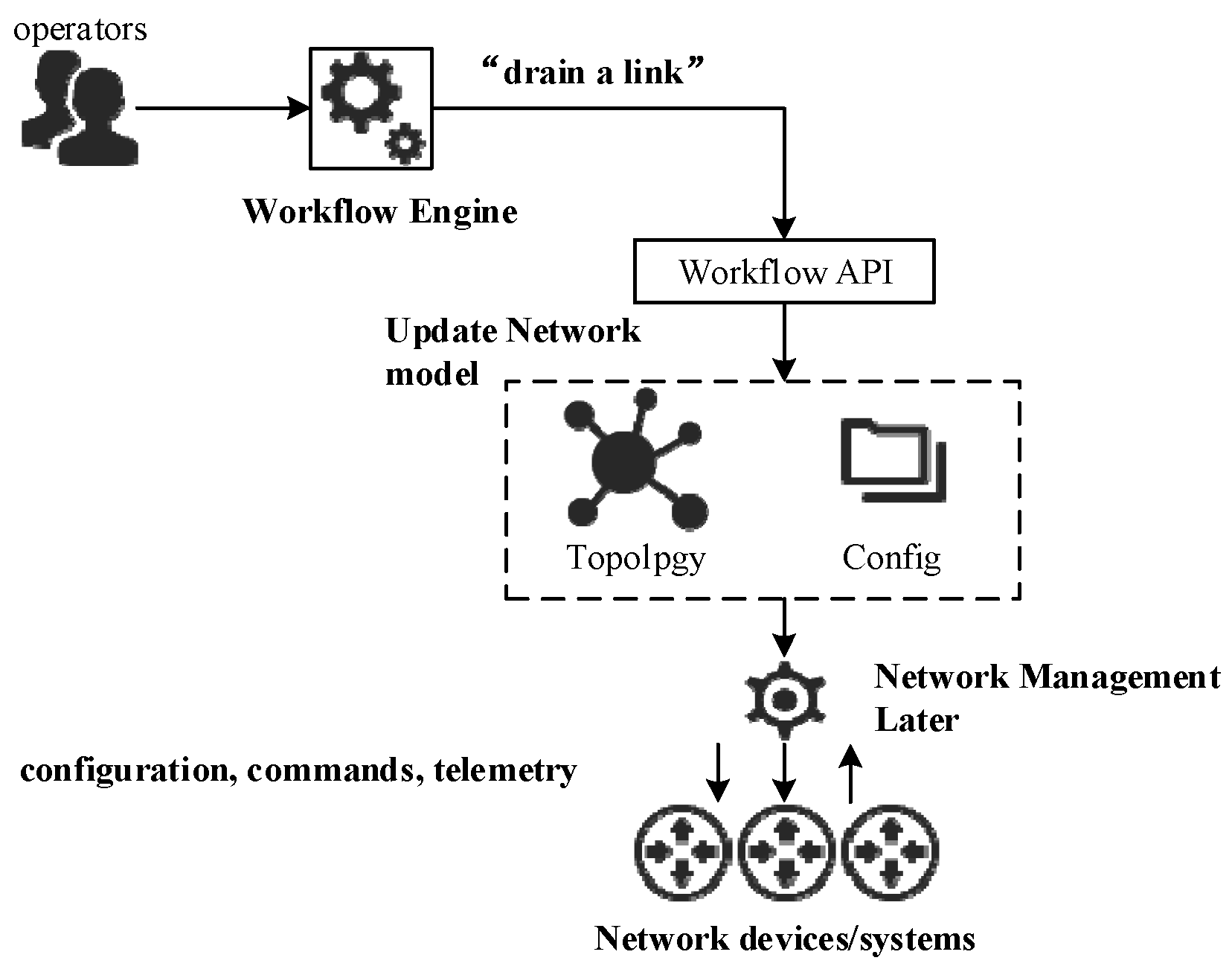

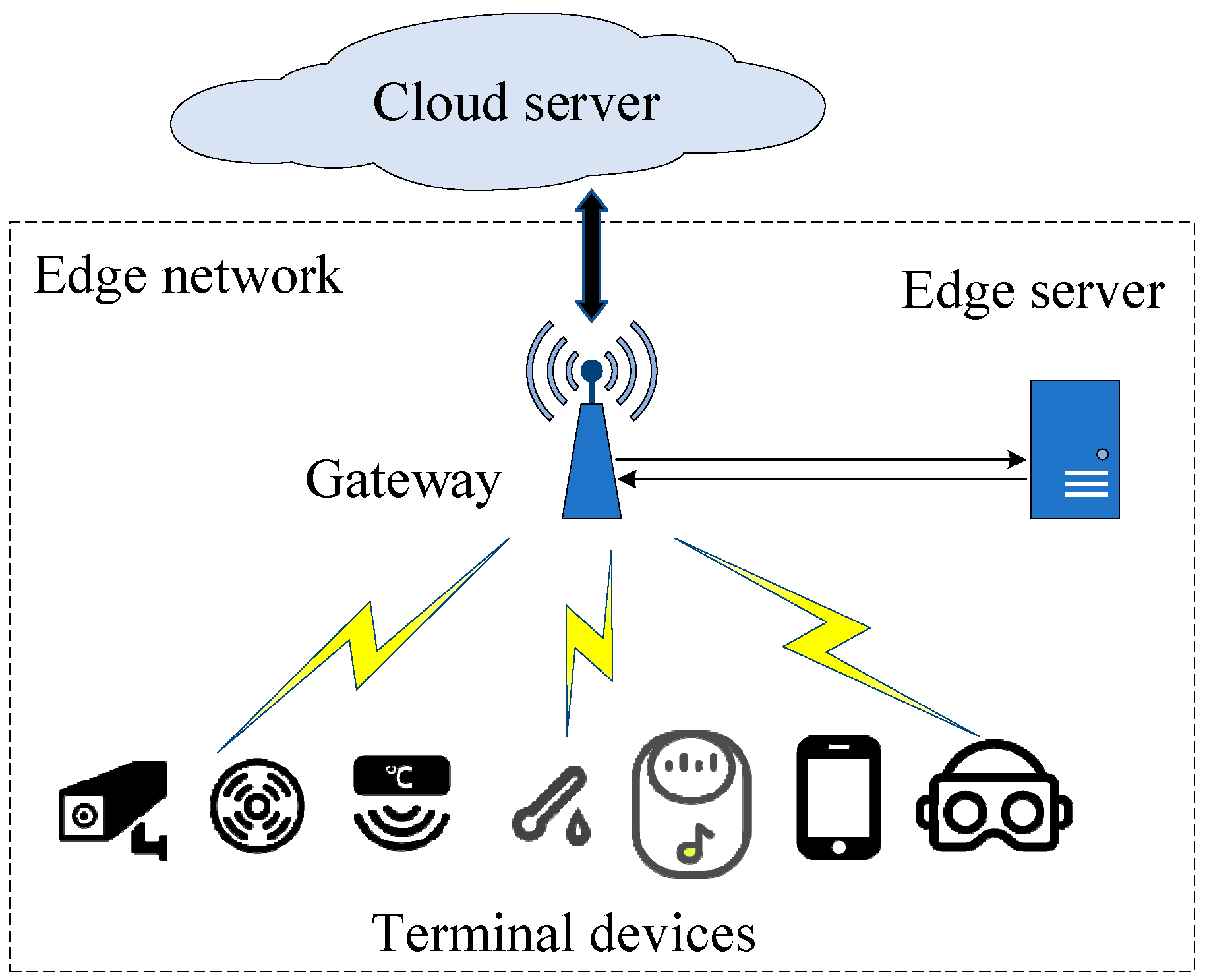
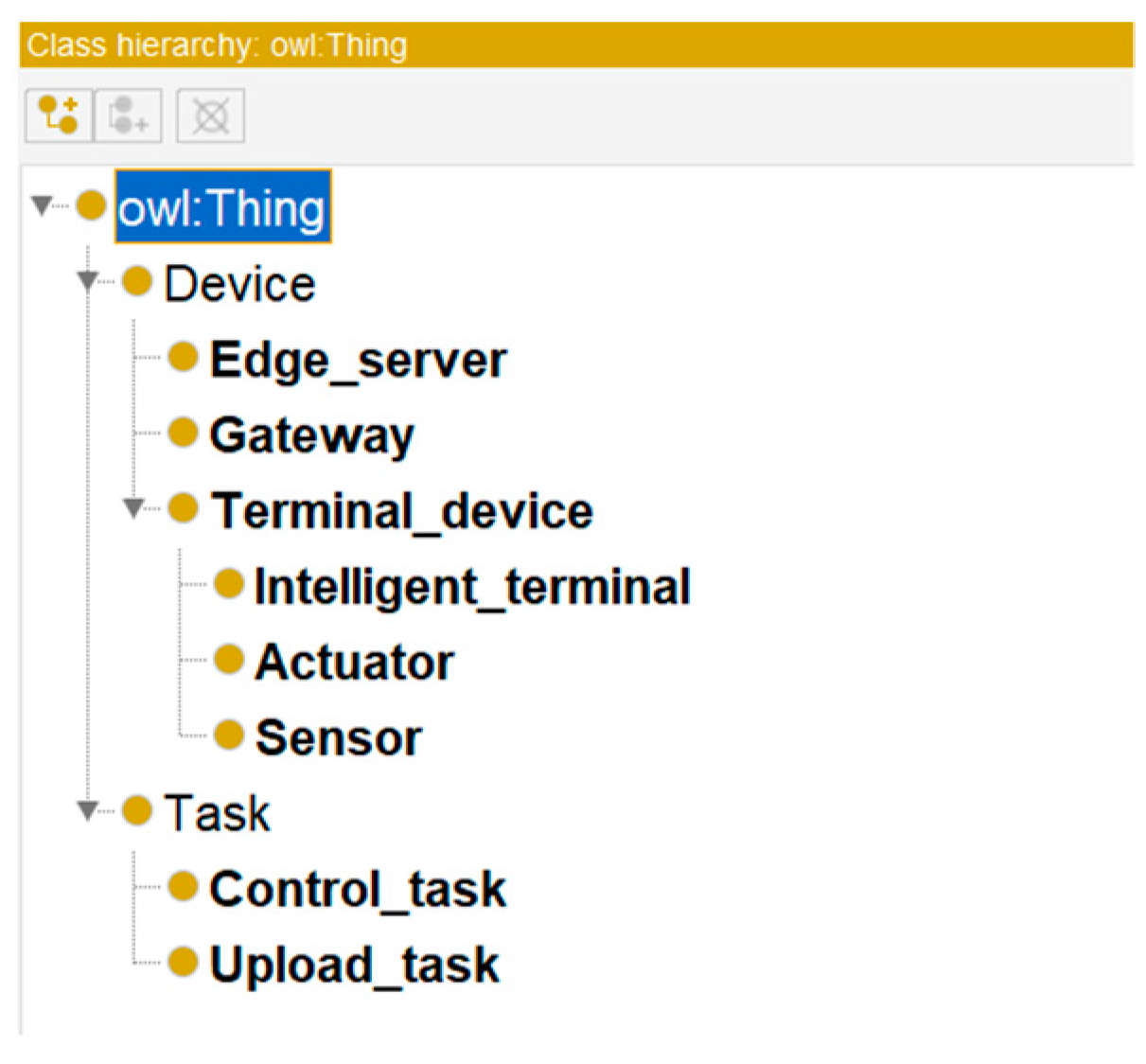

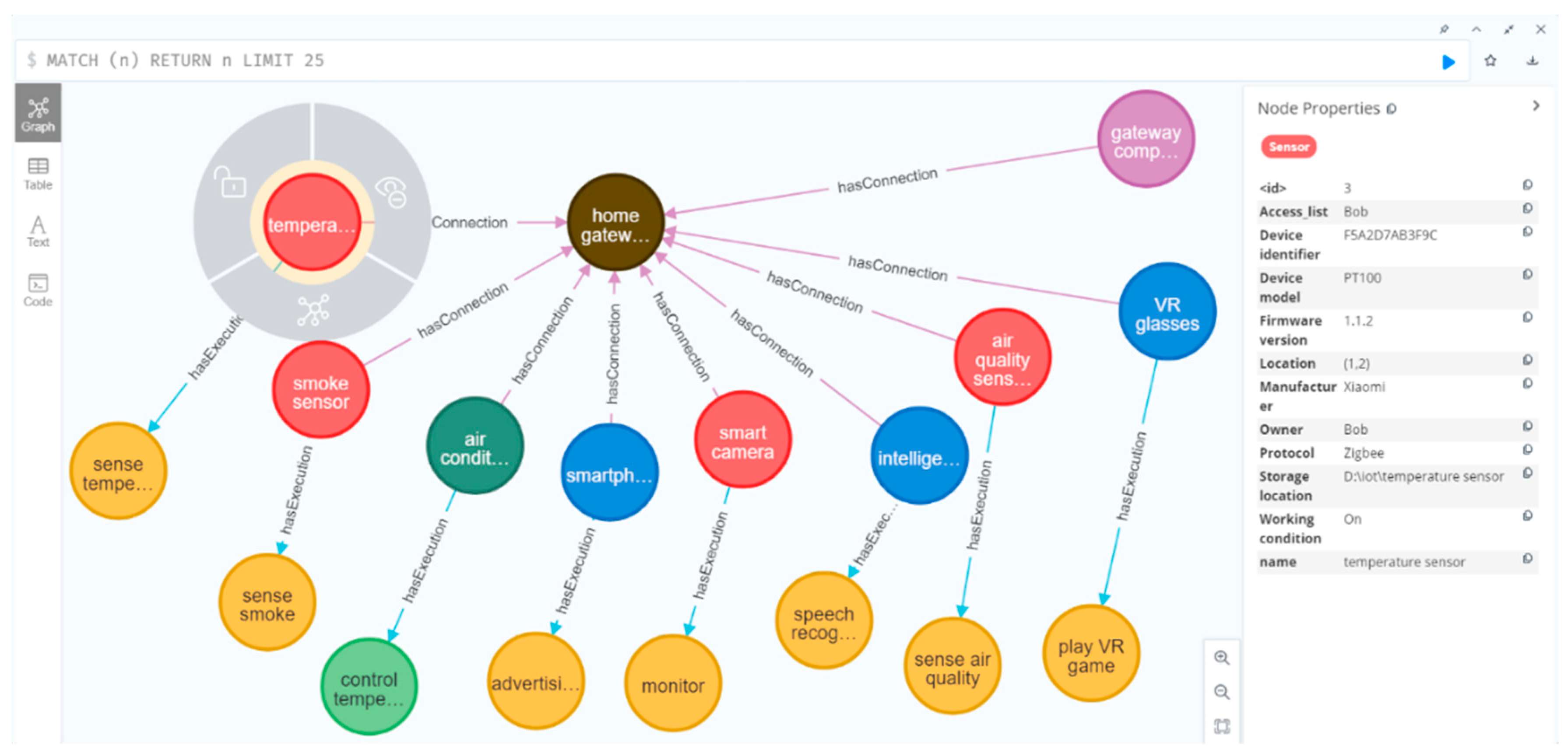
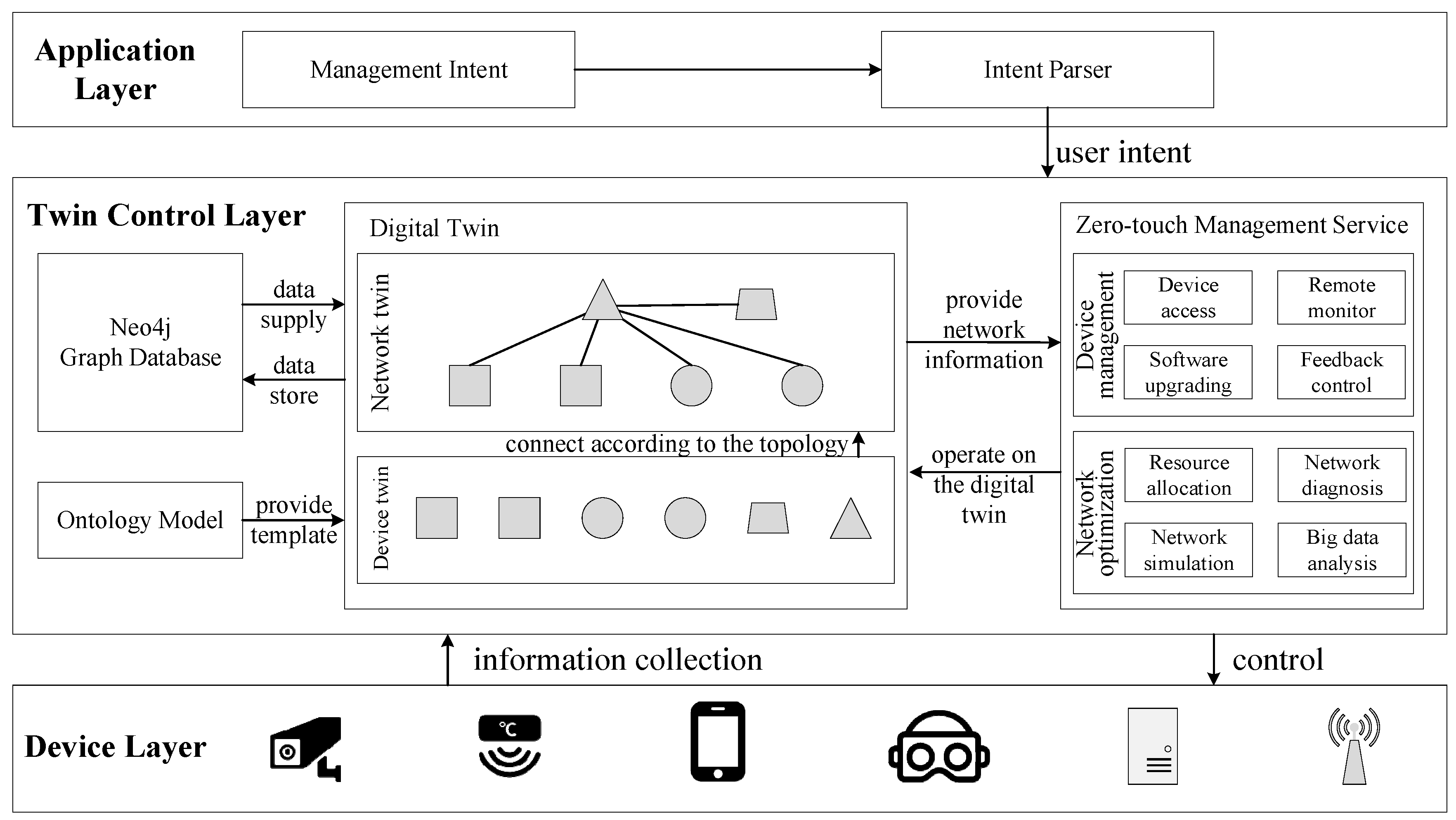


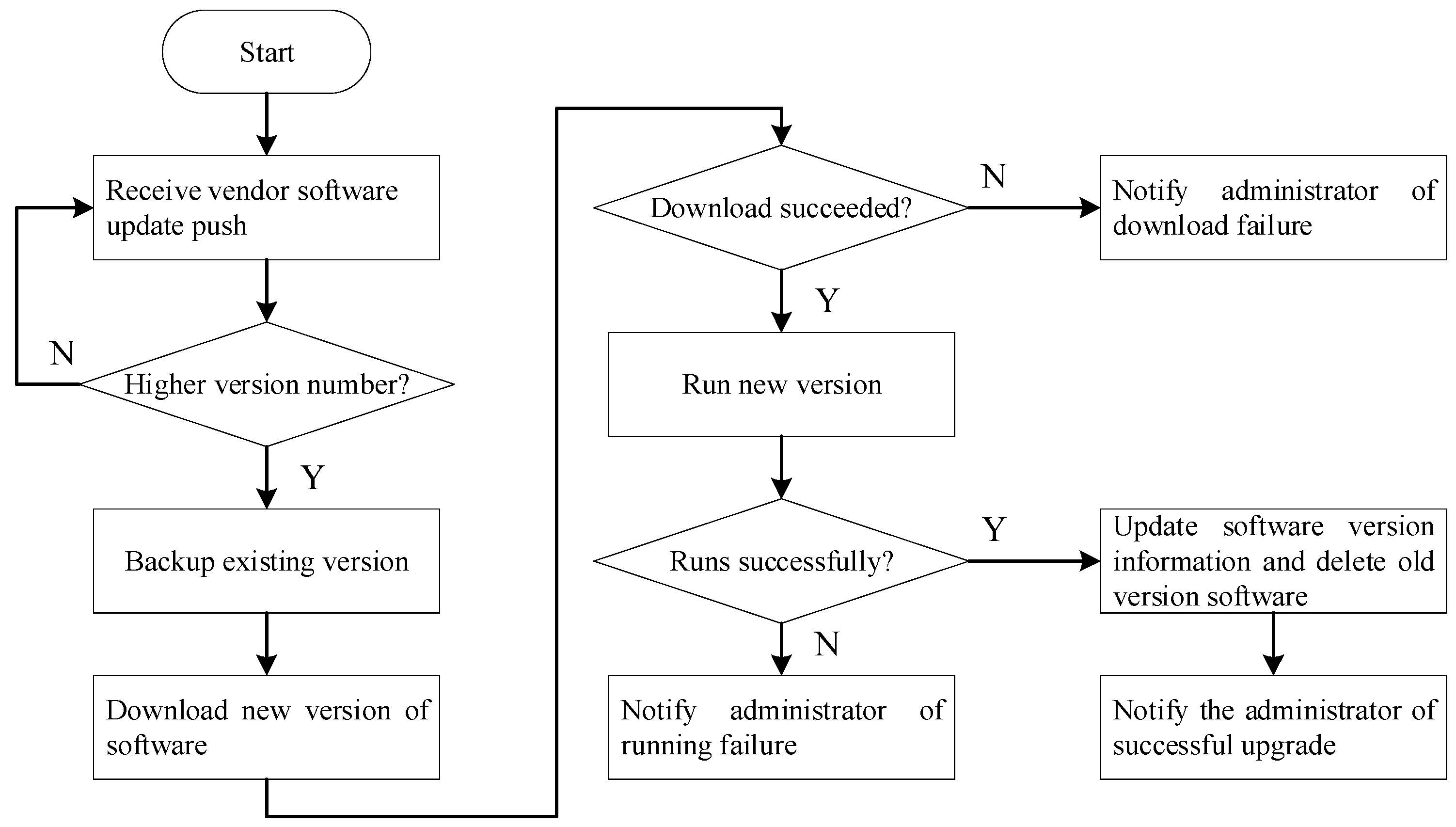
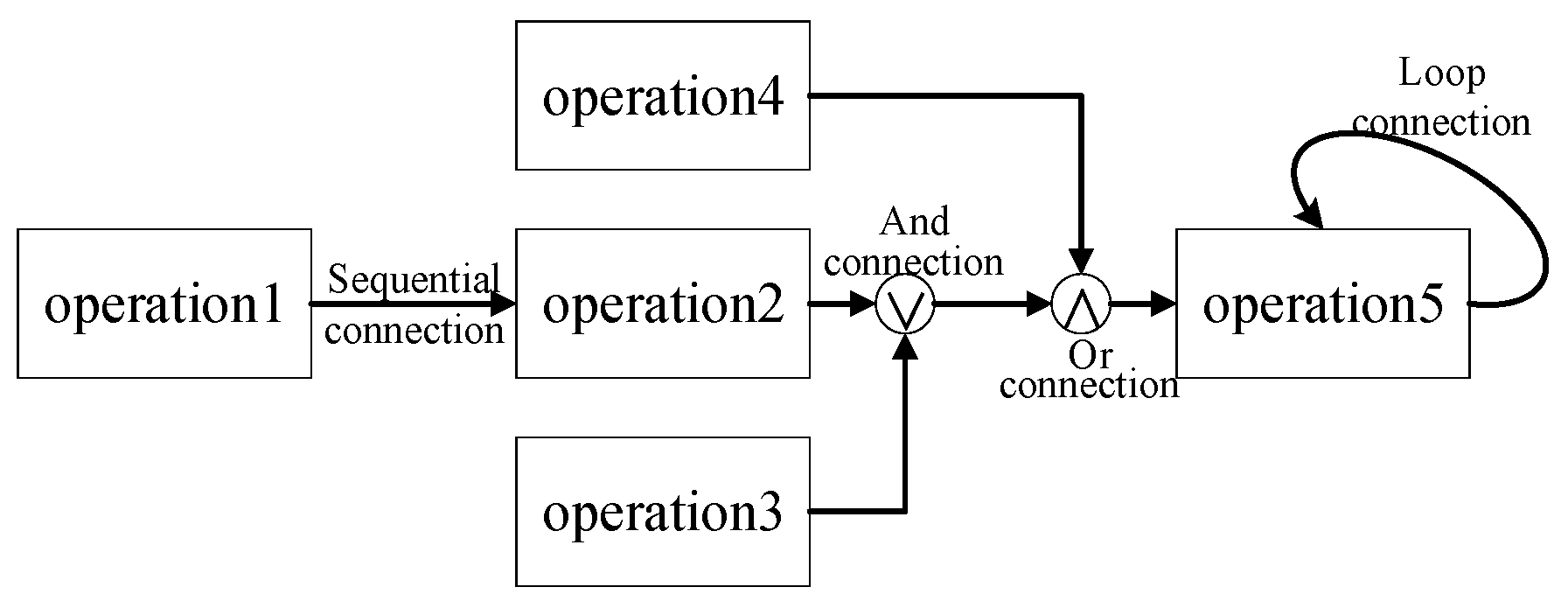


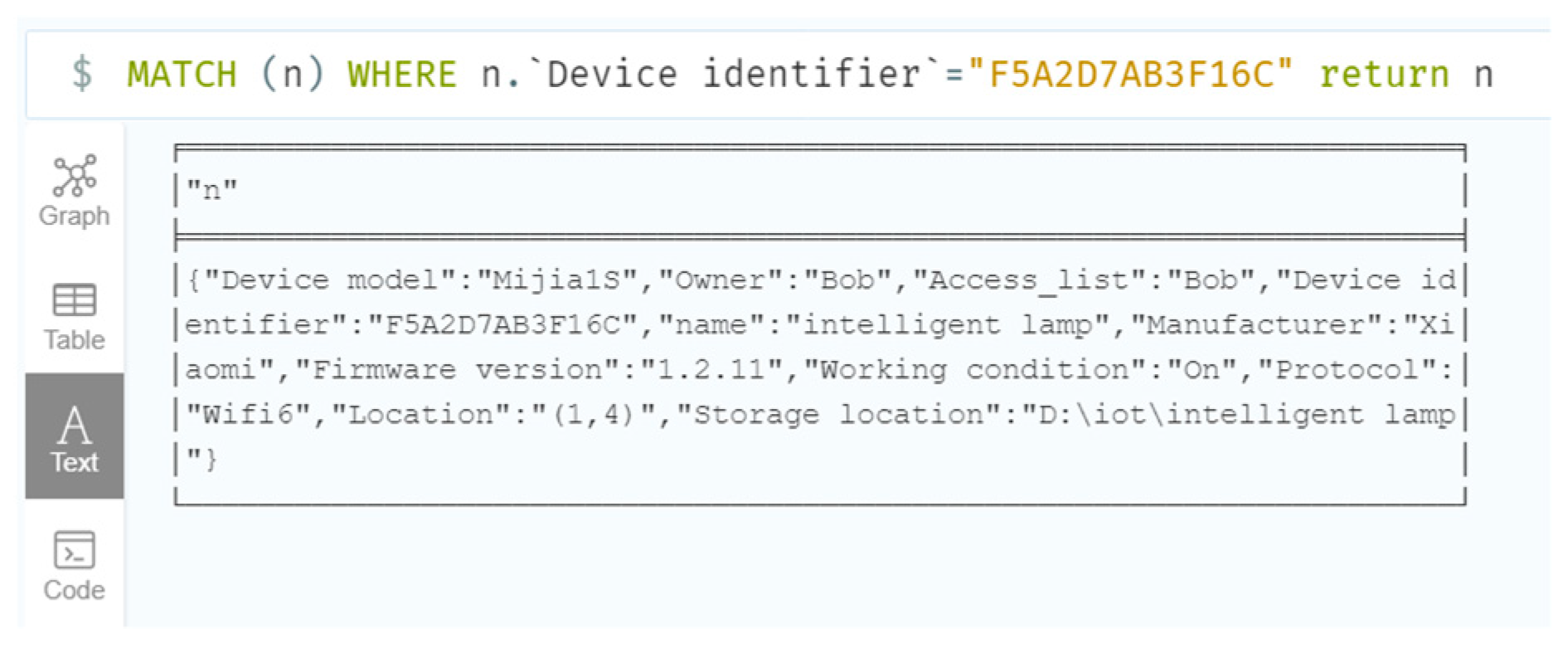
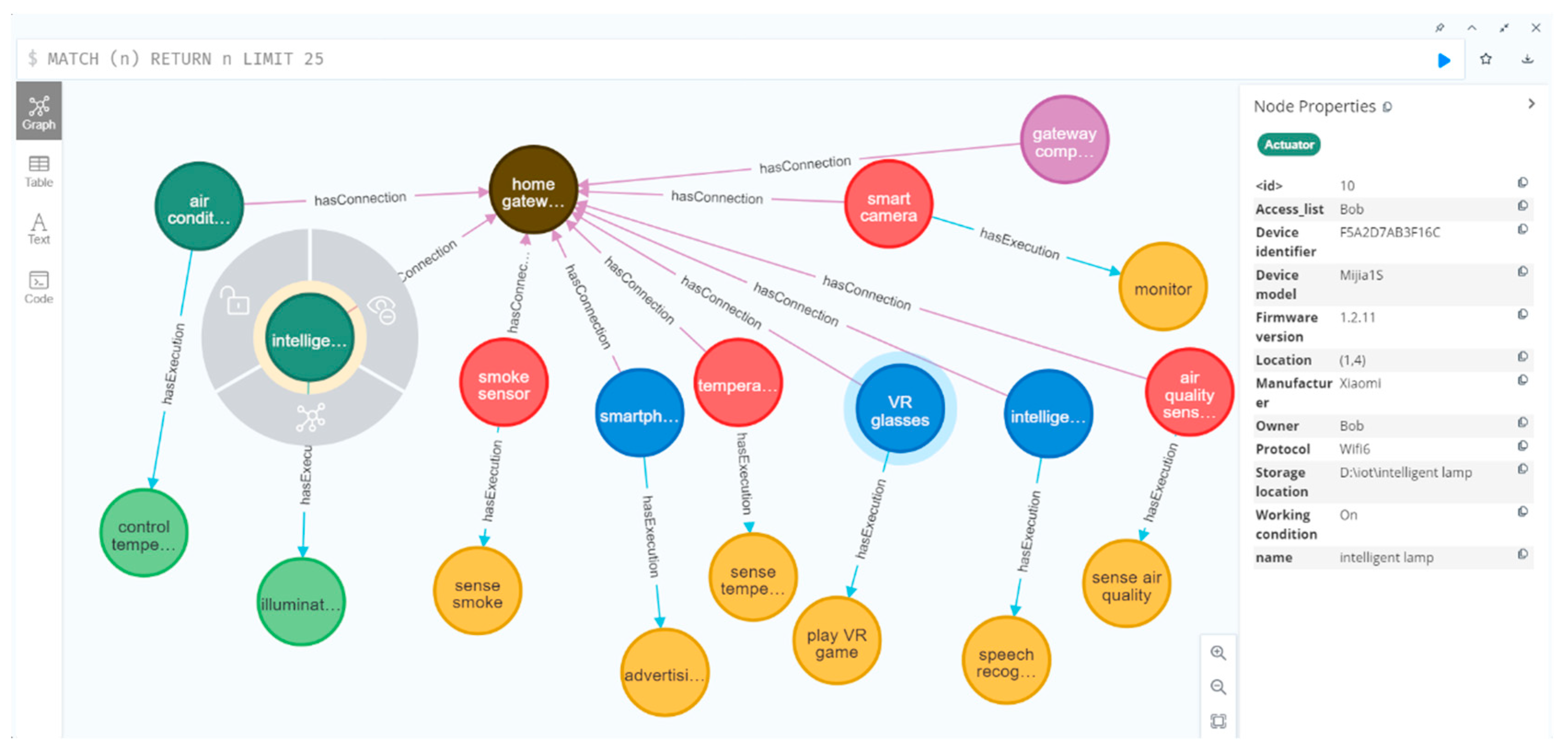
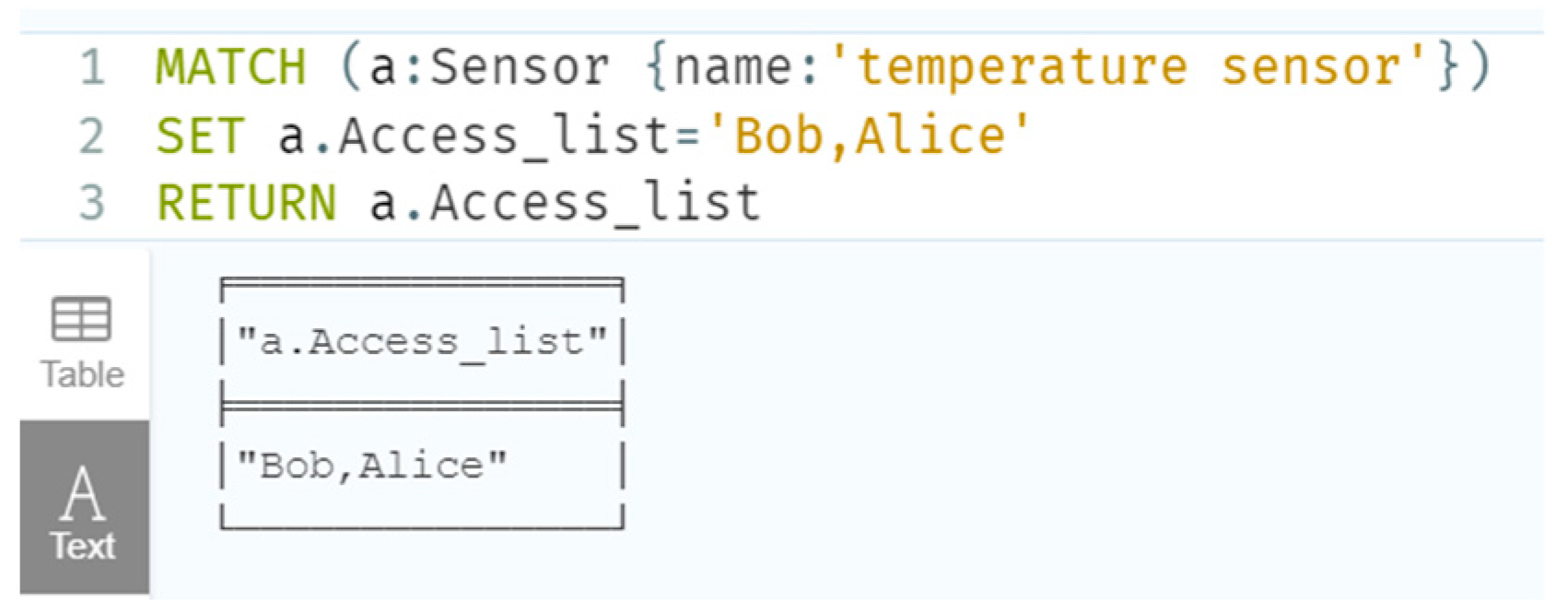
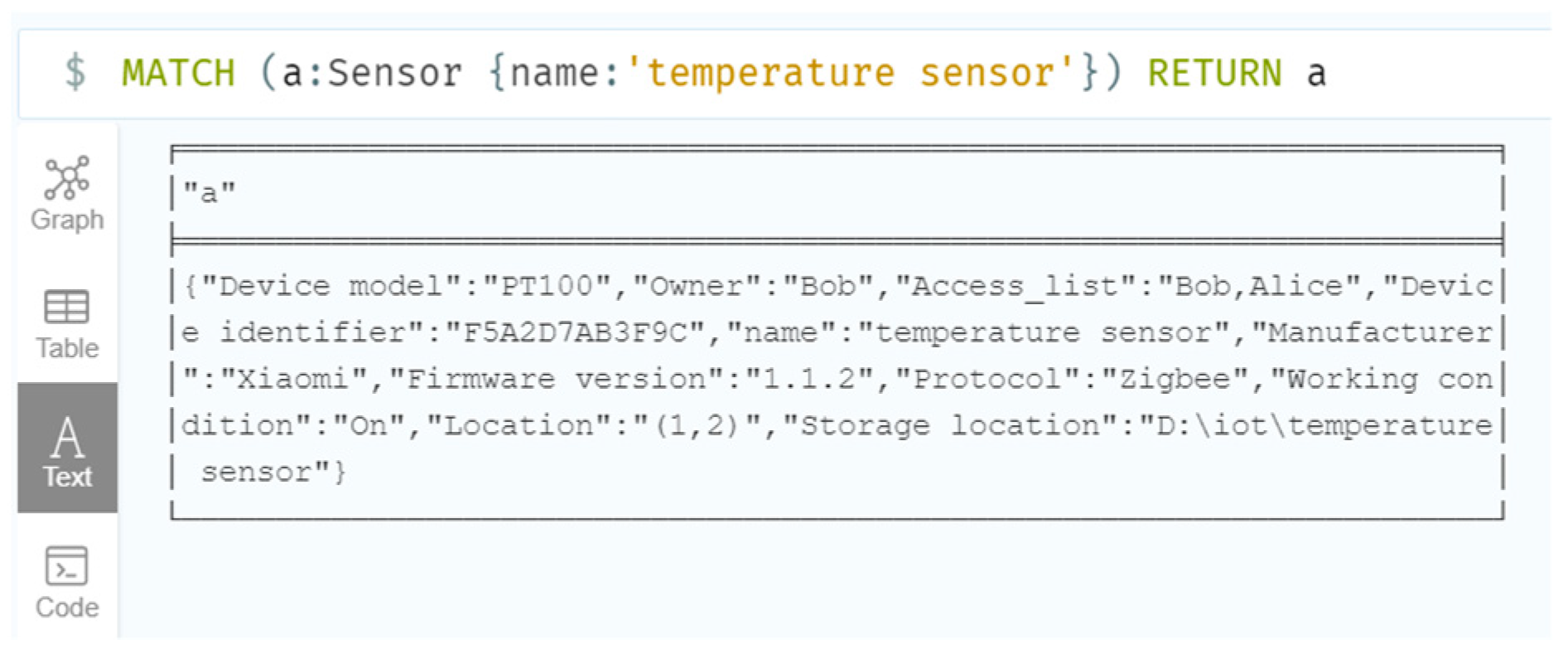
| LABLE | VALUE |
|---|---|
| Device class | Actuator |
| Device name | intelligent lamp |
| Device ID | F5A2D7AB3F16Ct |
| Manufacturer | Xiaomi |
| Device model | Mijia1S |
| Firmware version | 1.2.11 |
| Owner | Bob |
| Access list | Bob |
| Working condition | On |
| Protocol | Wifi6 |
| Location | (1,4) |
| Storage location | D:\iot\intelligent lamp |
| Task class | Control task |
| Task name | illumination |
| Task description | adjust the brightness |
| Required communication | 5bps |
| Required calculation | 0 |
Publisher’s Note: MDPI stays neutral with regard to jurisdictional claims in published maps and institutional affiliations. |
© 2022 by the authors. Licensee MDPI, Basel, Switzerland. This article is an open access article distributed under the terms and conditions of the Creative Commons Attribution (CC BY) license (https://creativecommons.org/licenses/by/4.0/).
Share and Cite
Ma, J.; Guo, Y.; Fang, C.; Zhang, Q. Digital Twin-Based Zero-Touch Management for IoT. Electronics 2022, 11, 4104. https://doi.org/10.3390/electronics11244104
Ma J, Guo Y, Fang C, Zhang Q. Digital Twin-Based Zero-Touch Management for IoT. Electronics. 2022; 11(24):4104. https://doi.org/10.3390/electronics11244104
Chicago/Turabian StyleMa, Jiali, Yuanbo Guo, Chen Fang, and Qi Zhang. 2022. "Digital Twin-Based Zero-Touch Management for IoT" Electronics 11, no. 24: 4104. https://doi.org/10.3390/electronics11244104
APA StyleMa, J., Guo, Y., Fang, C., & Zhang, Q. (2022). Digital Twin-Based Zero-Touch Management for IoT. Electronics, 11(24), 4104. https://doi.org/10.3390/electronics11244104








